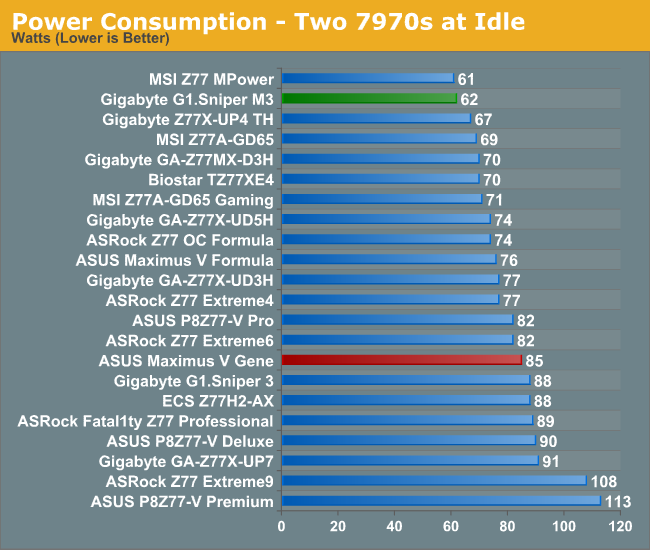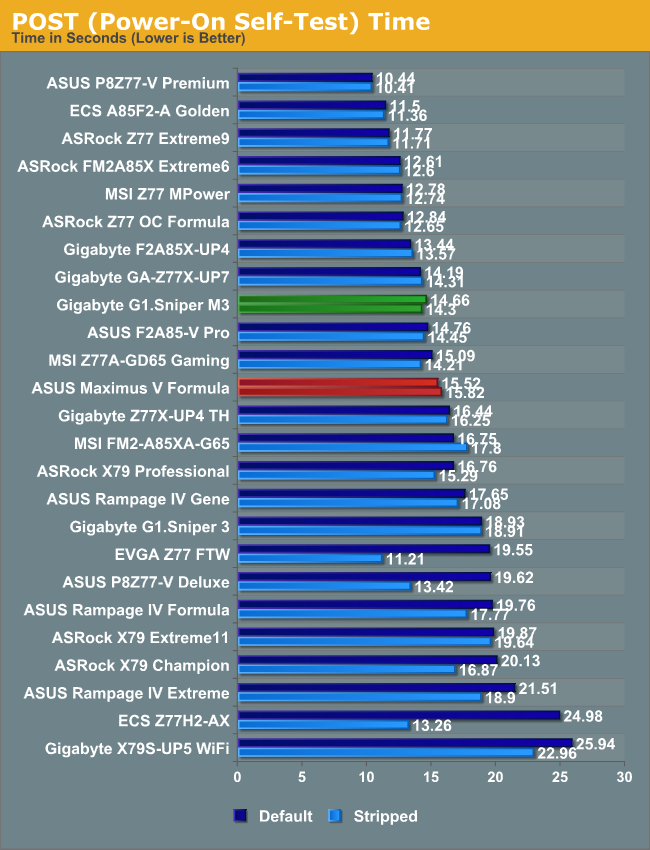ASUS Maximus V Gene vs. Gigabyte G1.Sniper M3 Review
by Ian Cutress on May 13, 2013 10:00 AM EST- Posted in
- Motherboards
- Gigabyte
- Asus
- MicroATX
- Z77
Many thanks to...
We must thank the following companies for kindly providing hardware for our test bed:
Thank you to OCZ for providing us with 1250W Gold Power Supplies.
Thank you to G.Skill for providing us with the memory kits.
Thank you to ASUS for providing us with the AMD GPUs and some IO Testing kit.
Thank you to ECS for providing us with the NVIDIA GPUs.
Thank you to Corsair for providing us with the Corsair H80i CLC.
Thank you to Rosewill for providing us with the 500W Platinum Power Supply for mITX testing, BlackHawk Ultra, and 1600W Hercules PSU for extreme dual CPU + quad GPU testing, and RK-9100 keyboards.
Software and BIOS
Normally as part of a review we would examine the Software and BIOS of each motherboard. Both the ASUS and Gigabyte boards have bigger brothers, wherein we tested and analyzed the offerings from both manufacturers. Please click to link through to the ASUS ROG MVF Software and BIOS analysis, or the Gigabyte G1.Sniper 3 Software and BIOS analysis.
Test Setup
Power Consumption
Power consumption was tested on the system as a whole with a wall meter connected to the OCZ 1250W power supply, while in a dual 7970 GPU configuration. This power supply is Gold rated, and as I am in the UK on a 230-240 V supply, leads to ~75% efficiency > 50W, and 90%+ efficiency at 250W, which is suitable for both idle and multi-GPU loading. This method of power reading allows us to compare the power management of the UEFI and the board to supply components with power under load, and includes typical PSU losses due to efficiency. These are the real world values that consumers may expect from a typical system (minus the monitor) using this motherboard.
While this method for power measurement may not be ideal, and you feel these numbers are not representative due to the high wattage power supply being used (we use the same PSU to remain consistent over a series of reviews, and the fact that some boards on our test bed get tested with three or four high powered GPUs), the important point to take away is the relationship between the numbers. These boards are all under the same conditions, and thus the differences between them should be easy to spot.

One would expect power consumption of smaller motherboards to be less than that of full sized ATX ones – in the case of the Sniper M3 at idle that is true, but when it is loaded with two GPUs during Metro2033, it matches some of the high end ATX models, and moreso than the full G1.Sniper 3. This could perhaps be related to the audio solution.
POST Time
Different motherboards have different POST sequences before an operating system is initialized. A lot of this is dependent on the board itself, and POST boot time is determined by the controllers on board (and the sequence of how those extras are organized). As part of our testing, we are now going to look at the POST Boot Time - this is the time from pressing the ON button on the computer to when Windows starts loading. (We discount Windows loading as it is highly variable given Windows specific features.) These results are subject to human error, so please allow +/- 1 second in these results.

Neither motherboard is able to hit a glorious 12 seconds for Windows 7 POST times with two GPUs installed.










31 Comments
View All Comments
Ristogod - Monday, May 13, 2013 - link
The Title of the article indicates you are comparing the G1.Sniper 3. Instead you use the G1.Sniper M3 in the review.IanCutress - Monday, May 13, 2013 - link
Thanks :) I've had the Sniper 3 on the brain. Though several pairs of eyes have read through and all missed the title.Ian
A5 - Monday, May 13, 2013 - link
I wish manufacturers were more willing to send you cheaper mATX boards.Neither of these boards really feel like a good value compared to cheaper things in the same companies' lines. I guess the ROG makes some sense if you really need the wi-fi card + SLI/XFire (which loses you the Intel NIC as a useful feature...), but still.
IanCutress - Monday, May 13, 2013 - link
It is something I am changing with Haswell. After initial launch reviews, I want to look at mATX. I've let the manufacturers know. That means gaming models and the cheaper end of the spectrum, perhaps in a couple of roundups focusing on price points or individually if people prefer the reviews that way.Ian
A5 - Monday, May 13, 2013 - link
I personally like round-ups better due to the fact that they make the writer make explicit comparisons, but I understand that they're way more work for you :PEither way I'll probably upgrade before it would be published, but I appreciate the idea of increasing coverage in that segment.
DanNeely - Monday, May 13, 2013 - link
I'm probably going to hold off until the USB3 fix refresh is out; so I should be able to read all the initial wave reviews before opening my wallet. My main box is going to be high OCed and water cooled; so I assume the boards I'm interested in will be in the initial flagship/near flagship review wave.MrSpadge - Tuesday, May 14, 2013 - link
Agreed - at these prices I wouldn't consider such mainboards at all.just4U - Tuesday, May 14, 2013 - link
A5, I don't see them as a good value compared to cheaper boards in the same company. My view has always been (with gaming matx) they are a great value when compared to more expensive boards in the same company. They pack a lot into these little boards /w features typically only seen in their highest end offerings.GeorgeH - Monday, May 13, 2013 - link
I had the Gene for about a week before replacing it. It was an awesome board, I just couldn't stand the coil whine. Sample size of 1, though, so did you notice any whine with your review sample?IanCutress - Monday, May 13, 2013 - link
No coil whine on my sample. I notice that some motherboards cause my testing PSUs to whine every now and again, especially in multi-GPU setups on gaming tests, but I can't say I had any with the Gene.Ian